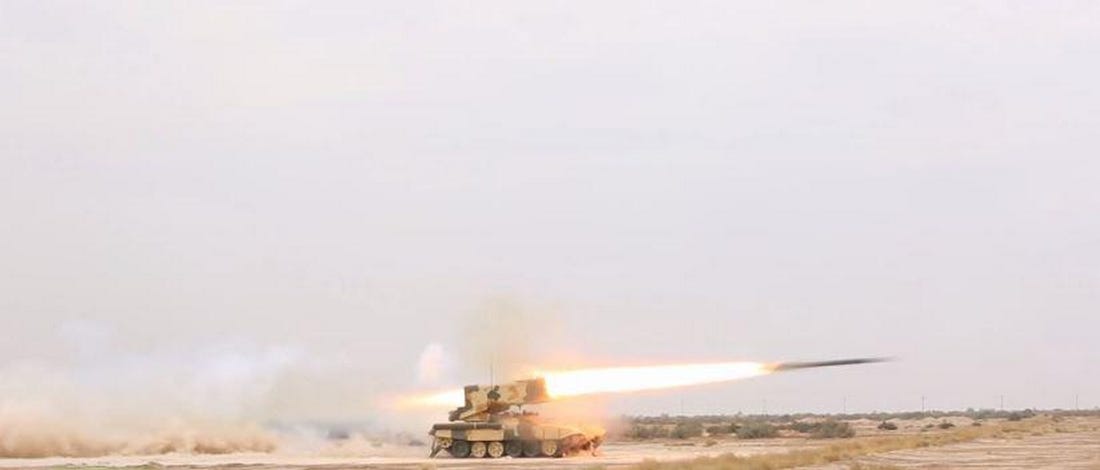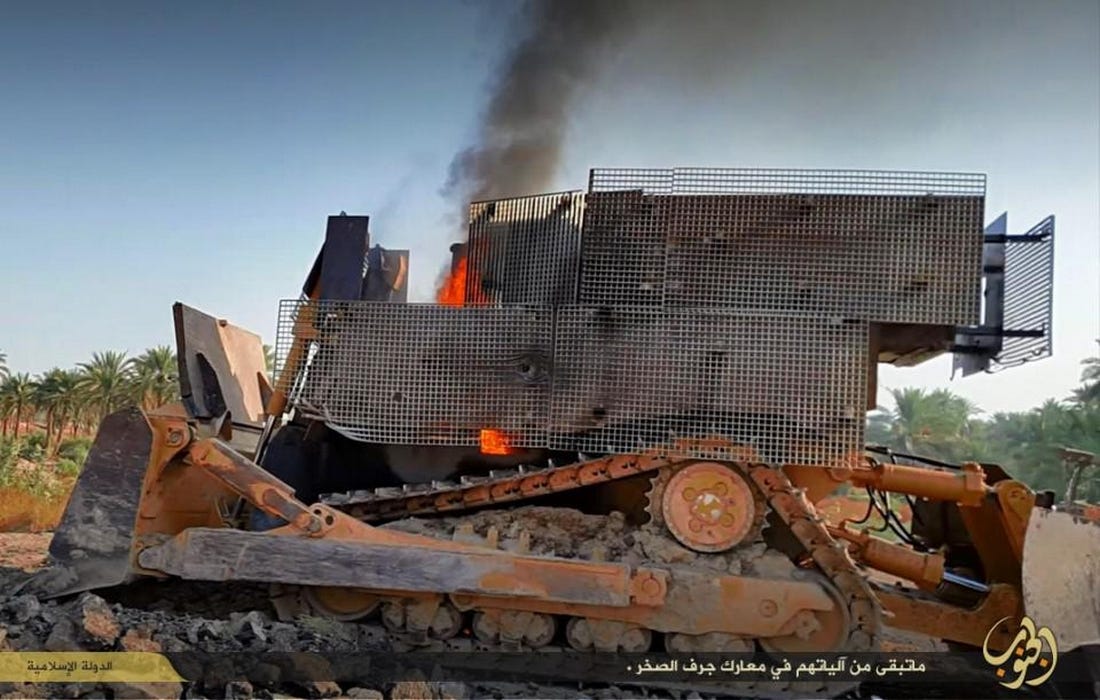The battle in Jurf Al Sakhar involved a surprising number of Shia groups
The past four months have been absolutely disastrous for Shia militia in Syria and Iraq. Although the militia have helped to slow Islamic State’s advance in Iraq, the Sunni militant group still managed to launch a major assault toward Baghdad’s international airport in October.
The Islamic State fighters got so close to the airport—a strategic installation for Iraq—that U.S. Army Apache helicopters had to join in the defense. The airport battle was so embarrassing for government forces and their Iranian commanders that some Iraqi officials, speaking to Iranian media, flat-out denied the attack had even taken place.
Iranian commanders in Iraq and the Shia militia groups they control were badly in need of a victory to shore up their influence in Baghdad.
To help lead the attack, some militiamen would slap armor on a bulldozer.
On Oct. 20th, fewer than three weeks ahead of the Shia Ashura holiday, Iranian major general Ghassem Soleymani paid a visit to Karbala, southwest of Baghdad. Immediately after visiting Karbala, Soleymani headed up a crucial operation to retake Jurf Al Sakhar from Islamic State.
Jurf Al Sakhar is a rural town on the Baghdad-Karbala road, approximately 60 kilometers south of Baghdad and 65 kilometers north of Karbala. Jurf Al Sakhar has a population of 80,000 in peacetime. With its large Sunni community, it’s become an important staging area for suicide bombers and terrorist attacks targeting Shia holy cities in southern Iraq, particularly Karbala.
Jurf Al Sakhar was the perfect target for a monumental victory to restore the Shia militias’ vitality.
 Above—Iraqi police arrive in Jurf Al Sakhar in October. At top—Iraqi troops attack militants in Jurf Al Sakhar. AP photos
Above—Iraqi police arrive in Jurf Al Sakhar in October. At top—Iraqi troops attack militants in Jurf Al Sakhar. AP photos
The Iraqi army had carried several raids in the area in March 2014, before Islamic State’s rampage—and the army was preparing for a full assault in mid-September, only to be interrupted by the militants’ attacks toward Baghdad.
Iraqi special forces held positions around the area and U.S. Air Force supported them with several air strikes in late September. Shia militia staged to carry out the final attack and win the battle.
A large number of Shia militia groups participated in the operation, presumably in order to share in the glory that would flow from Jurf Al Sakhar’s capture.
The groups included the Badr Brigades, Asaib Ahl Al Hagh, Kataeb Tayar Al Resali, Hezbollah Nojaba, Seraya Al Salam, Seraya Al Khurasani and others. The militias vary widely. Some are loyal to the Iranian supreme leader. Others follow Iraqi Shia cleric Moqtada Al Sadr.
Iran and Al Sadr have a complicated history. In 2007, the U.S. Army and the Iraqi regime under Iran’s ally Nouri Al Maliki launched a major operation in Baghdad’s Shia Sadr city.
Al Sadr himself was compelled to flee to Qom in Iran. Iranian officials explained the purpose of the cleric’s travel as “religious education.” But Al Sadr’s close allies described it as “soft detention.”
 A TOS-1E fires outside Jurf Al Sakhar. Photo via militia social media
A TOS-1E fires outside Jurf Al Sakhar. Photo via militia social media
The battle for Jurf Al Sakhar began on Oct. 24, with militiamen launching Qaher rockets at the town’s militant defenders. Qaher is an improvised weapon featuring a 100-pound barrel bomb on top of a basic rocket engine.
The fire support continued with Iranian-made 122-millimeter and 107-millimeter rockets, 120-millimeter mortar fire and 130-millimeter field guns pummeling the area. Finally, the monstrous Russian-supplied TOS-1E thermobaric rocket system made its combat debut in Iraq.
After the intense barrage, mechanized columns advanced toward the city from the southeast. The Iraqi army deployed its modern, Ukrainian-made BTR-4 armored fighting vehicles, which proved to be crucial in defeating at least two ambushes during the charge.
After reaching residential areas, Shia militiamen cleared the houses one at a time. By nightfall, the operation was a success. Iraqi officials claimed 200 Islamic State combatants died in the clashes.
On the morning of Oct. 25, Islamic State launched its counteroffensive. A suicide bomber driving a captured Humvee packed with explosives killed around 50 Shia fighters. Militant mortar fire from outskirts of Jurf Al Sakhar incurred additional Shia casualties.
Despite the counterattack, the Shia militia managed to move through and north of Jurf Al Sakhar at a steady pace. On Nov. 7, a lesser-known group called the Malik Ashtar Battalions claimed it had cleared Al Asirat village some 24 kilometers north of Jurf Al Sakhar.
 The armored bulldozer in flames. Photo via Islamic State social media
The armored bulldozer in flames. Photo via Islamic State social media
The last fighting took place on Nov. 10. That morning, a Badr Brigades mechanized column attempted to advance northwest of Jurf Al Sakhar. The column consisted of M-113s, Humvees and armed pickups, all led by the armored civilian bulldozer.
While trying to bypass an obstacle on the road, the column came under fire. A rocket destroyed one of the Humvees. Then the bulldozer took a hit. The cage armor around the engine proved to be hard to penetrate. Islamic State combatants fired three RPGs, finally punching through the armor and killing the driver.
The Badr troops fled, leaving behind three Humvees, two trucks and an M-113 for the Sunni militants.
A wave of propaganda followed the operation, especially in Iranian media. Iraqi militia leaders including Hadi Al Amiri traveled to Iran to attend religious ceremonies with Soleymani.
The most interesting piece of Iranian propaganda may have been an interview with Sheikh Jaber Rajabi, a representative of Asaib Ahl Al Hagh in Iran. Jabbari insisted that coalition forces, led by the U.S., played no role in the operation in Jurf Al Sakhar.
He directly threatened to attack any Americans in Iraq, “except the embassy staff.” He also claimed that his militiamen had discovered cruise missile launchers hidden in Jurf Al Sakhr, poised to bombard Ashura celebrations.
No comments:
Post a Comment